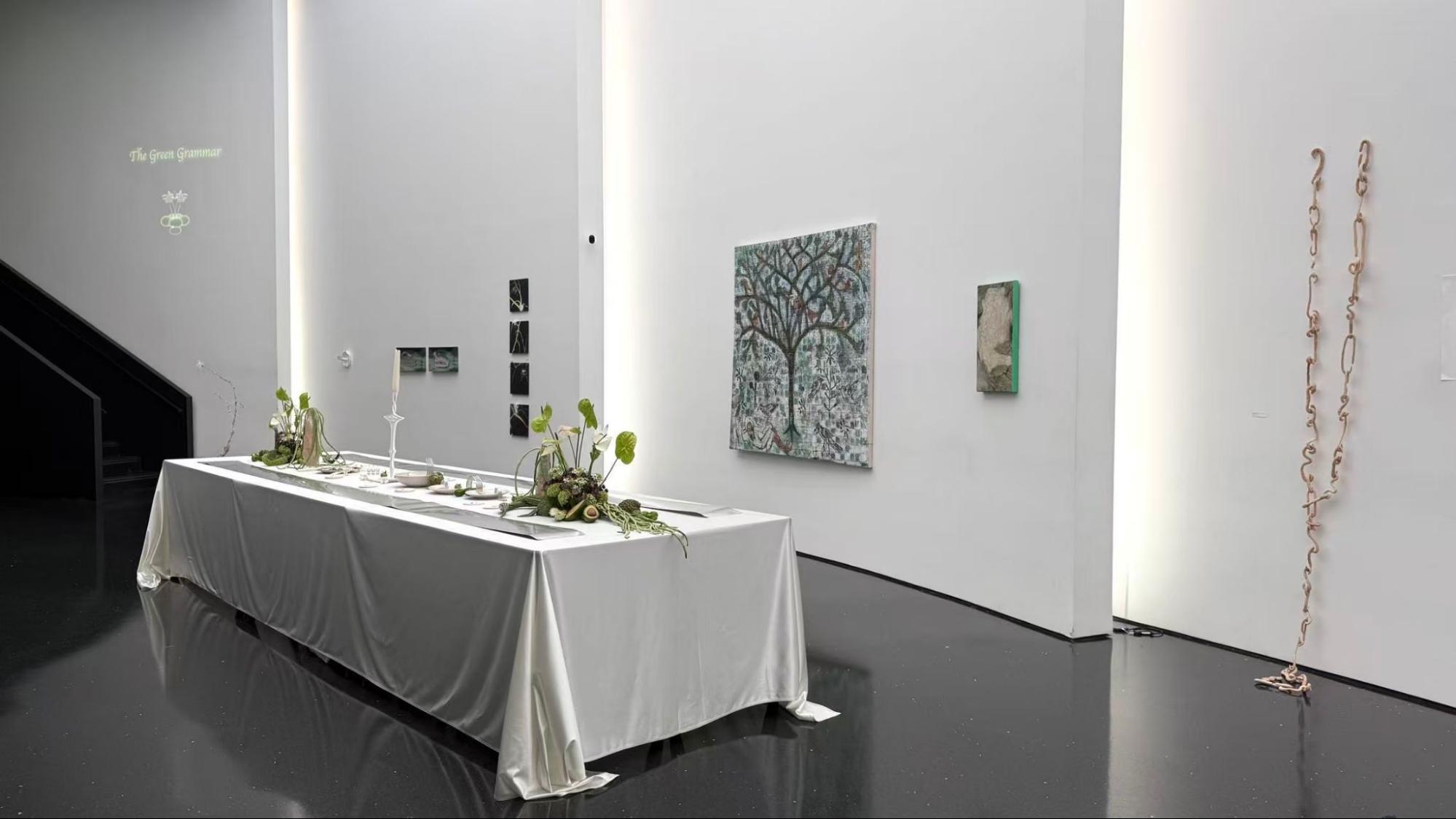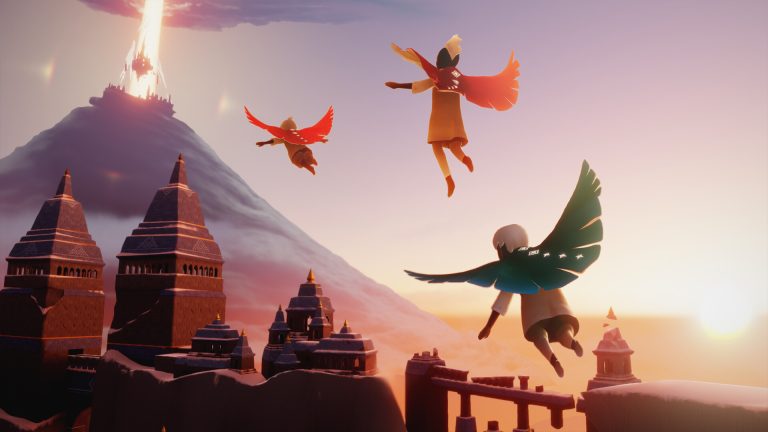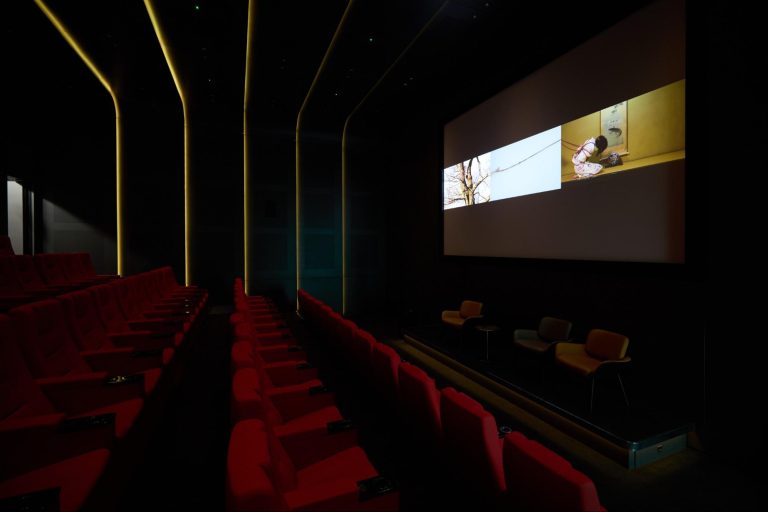When you bite into a fruit, pause. When you run your fingers across a leaf, pause. Let each pause be a line break in the prose of routine.
John Cage famously said in his Lecture on Nothing “I have nothing to say and I am saying it and that is poetry as I need it”. This mystical, contemplative nothing is shining and free in curators Moyu Yang and Chang Wang’s The Green Grammar, produced, supported and co-curated by host Gallery, ArtSect. The exhibition runs from June 27 to June 29 at art’otel, Hoxton.The exhibition was blooming with paintings, sculptures, ceramics, films, and most importantly – food and flowers. The Green Grammar draws on spirituality, ecology, mysticism, the body, and philosophy of language. This exhibition does not seek to dualistically answer questions regarding these ideas, but instead gestures to the shifting nature of these ideas within ourselves, our natural world and our created world.
ArtSect Gallery is a nomadic entity that builds, produces, and curates both physical and digital exhibitions across London, Athens, and the Middle East. Their focus lies in subtle geopolitics, psychology, LGBTQ+ voices, and emerging immersive and sensory practices. Incubating new artists and fostering cross-border communication between regions presents both logistical and social challenges—challenges that ArtSect is actively exploring and will continue to engage with in the years to come.
“Green Grammar was a joy to produce and a wonderful opportunity to experiment with sensory and aural experience, blending curation, literature, and human touch. We are very proud of our curatorial partners, Moyu and Chang, and look forward to more experimentation, public interaction, and future productions.”
—Christian Dyson, Co-founder, ArtSect
These works engage more with the somatic experience of language and dining, rather than focusing on spoken language itself. As a whole, the exhibition moves beyond conventional notions of mindfulness or meditative experience. Rather than inducing a state of calm, the works invite participants into a deeper, contemplative awareness.
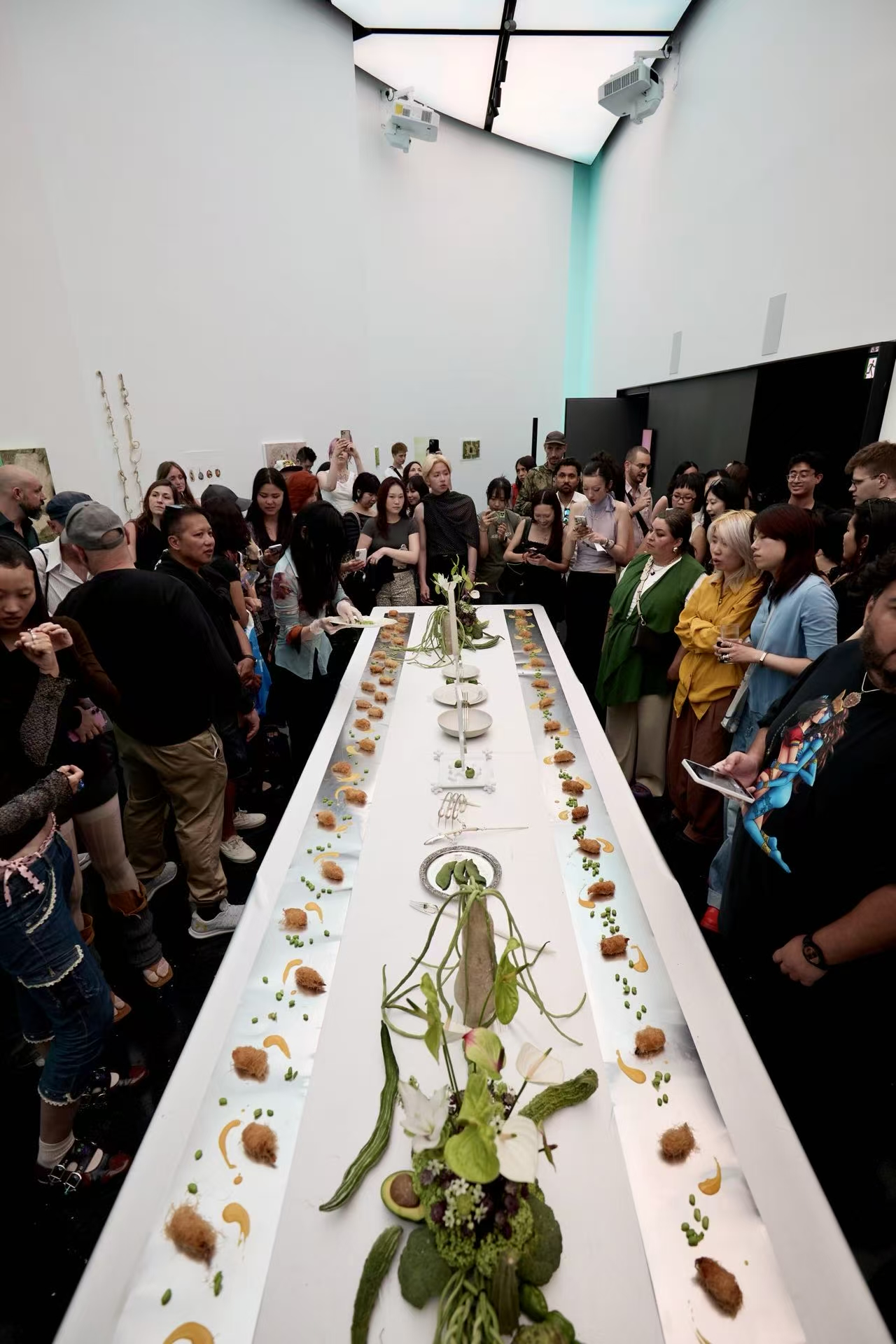

Courtesy of the artists and art’otel London Hoxton Gallery. Photography: Huaiyi Du
At the opening night, Lancy Liu, a sensory artist who works primarily with food as her medium, curated a four-course dining experience for the debut night of The Green Grammar. She specialises in using experimental approaches to restructure edible materials, exploring how food can function as language and narrative. The social aspect of this experience must also be emphasised, as a warm and inviting atmosphere beamed throughout the night. Her practice brings together edible sculpture, biomimetic structures, and aforementioned based syntax, placing controlled craftsmanship alongside the unpredictable beauty of natural transformation.
Beginning with Verdant Island, the language of plants grew like a mycelial web. This was followed by Orchard Blossom and Dew of Dawn, concluding with the edible sculpture; material language. The base of both works is made from bread-based edible sculpture, shaped by hand to resemble tree bark and weathered stone. The pieces had naturally fermented and cracked in time – their quiet transformation embodying the space where memory gathers and language begins, allowing the plants they held to speak.
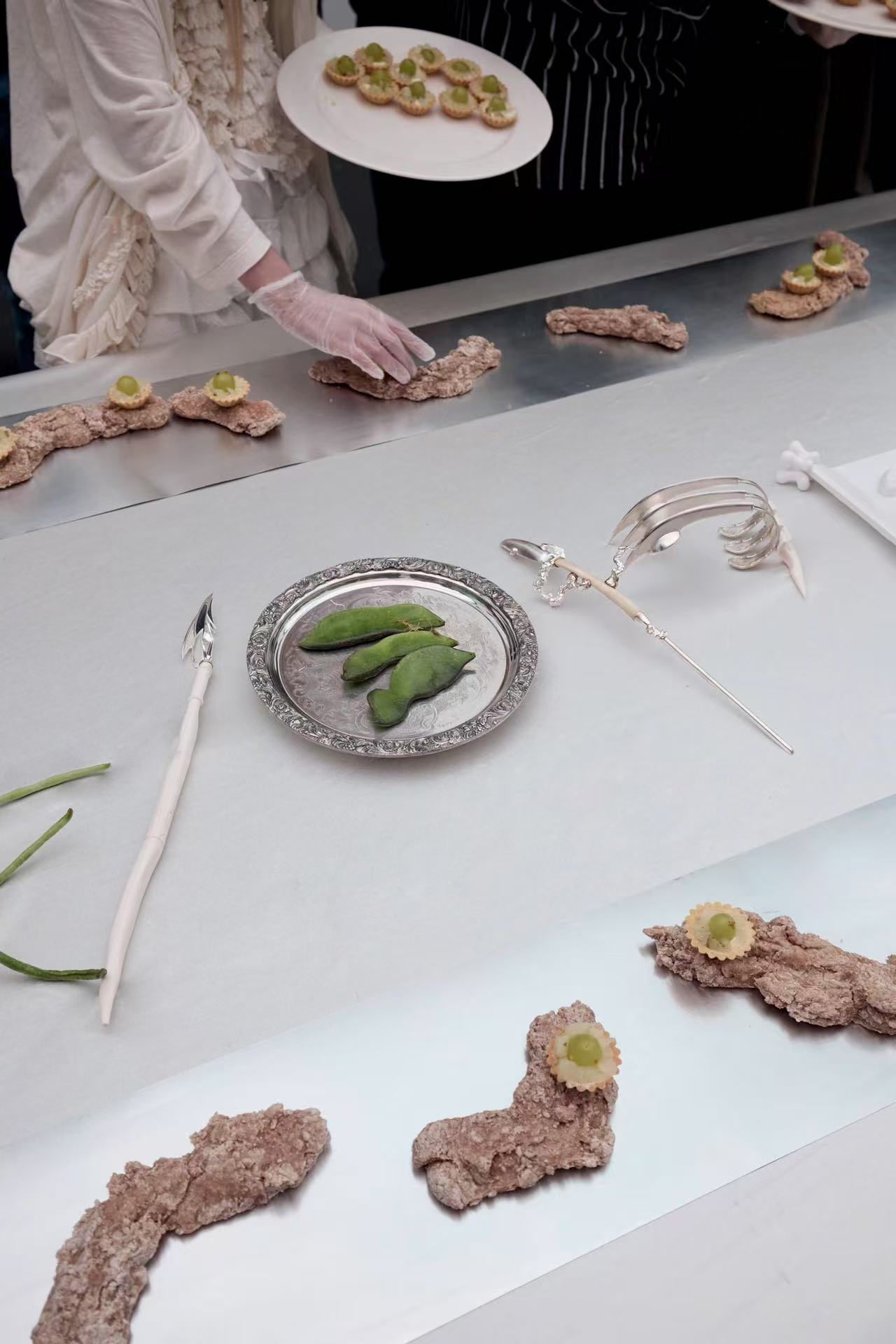

Lancy Liu’s Orchard Blossom & Dew of Dawn (2025)
Courtesy of the artists and art’otel London Hoxton Gallery. Photography: Huaiyi Du
As an ecosystem, the flowers and set all felt wholly unique and complementary – necessary and uplifting to each other. Artist and florist, Phong Anh Nguyễn. Her brand, Fleur De Lune (Flower of the Moon, or peace lily – nature’s lunar pacifier) lends Southeast Asian shou dance with Western floral craftsmanship, forming a cross-cultural harmony rich in nuance. Her work transcends traditional floristry, entering into art and cultural dialogue — a continuing song of heritage and adopted home. Like Liu’s contributions, Nguyễn’s floral arrangements were created specifically for The Green Grammar.
Together, these three elements — food, flora, and form — produced a rich psychosomatic experience, where the audience’s participation and interpretation evolved into a living extension of the artwork itself. The work enabled an ongoing dialogue across the gallery: a chorus of community and shared pleasure.
The food and flowers were gorgeously complemented by an array of artworks. Yang’s work Set, a modular candelabrum assembled in its grandest form for the occasion, gestures toward the shifting identities women navigate between private and public realms. Its presence illuminated Liu’s piece which, owing to its sensational taste, was devoured not so mindfully, yet with undeniable joy.
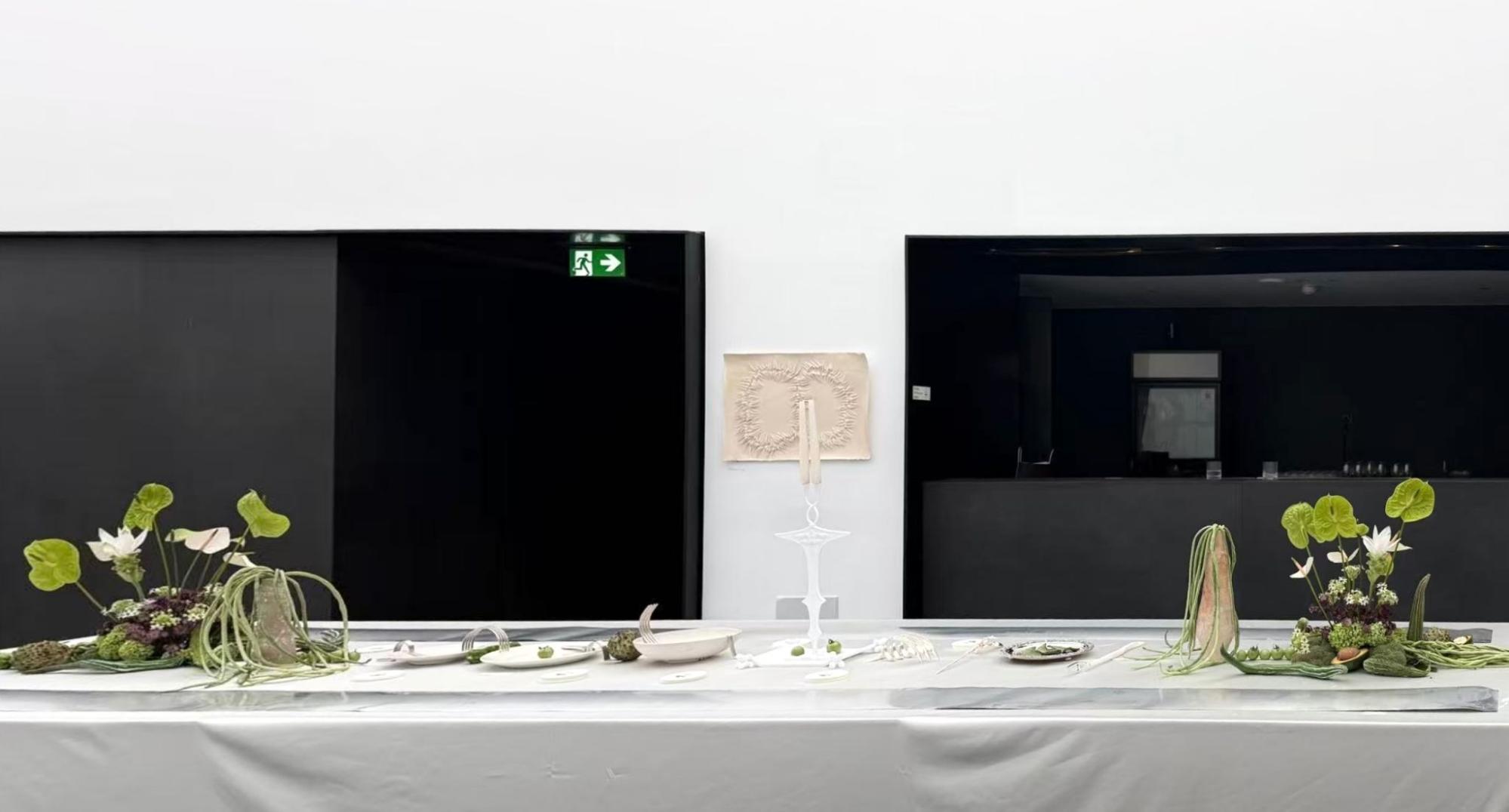

Courtesy of the artists and art’otel London Hoxton Gallery. Photography: Huaiyi Du
Ruiyi Wang’s The Restaurant finds its place seamlessly within the exhibition. In this work, forks twist and stretch around elegantly crafted ceramic bowls, subtly distorting the familiarity of domestic dining. Her sculptures challenge the social rituals embedded in table settings, exposing a primal, almost feral instinct beneath the veneer of etiquette.In contrast, Ruixin Wang—an accessories designer and object artist—explores cutlery as a symbol of power and social hierarchy. Her project uses bones to represent both life and consumption. By transforming discarded bones into wearable tools, she reverses the roles of predator and prey, subverting the elite’s weaponised utensils and challenging notions of status through everyday objects.
Nearby, Anyi Ji’s Moved by the Stirrings of the Heart (2025) features white stoneware vases and a shell cradling a flourish of green plant life. The arrangement draws on the aesthetics of wabi-sabi, celebrating imperfection and impermanence. The texture of the plants mirrors the vases’ own rough surfaces, blurring the line between vessel and growth, containment and becoming.
As the audiences participate in the work—and indeed become part of it—they are surrounded by a multitude of pieces from talented young artists.Directly opposite the table stands the exhibition’s largest piece: The Dream of the Road by James Lang, a sprawling tree set against a muted blue sky. Inspired by early medieval Christian art, the painting conceals and reveals a message embedded in a grid across its surface, offering a visual meditation on revelation, memory, and the sacred.
Adjacent to Lang’s work is a textured canvas by Jingshan, who uses cracked tree bark as a metaphor for human fragility and resilience. Through the repeated layering and scraping of paint, she echoes the way bark naturally accumulates and erodes over time—inviting reflection on vulnerability, endurance, and the passage of time.
Beside this is Caitlin Hazell’s sculptural installation: a delicate chain formed entirely from bread. By transforming this humble, universally recognisable material into a symbol of quiet restraint, Hazell explores the weight of the mundane and the invisible rituals that shape daily life.
Continuing along the gallery’s contours, we encounter Blossoms of Decay by Wanting Wang. In this piece, rotting food is photographed as vibrant floral life bursts from its core. By embedding vitality into decomposing forms, Wang questions whether human intervention generates renewal or imposes corruption. The work challenges our perceptions of beauty, transformation, and the fragile illusion of impermanence.
Yichen He’s Flower and the Scarlet Omen merges cyanotype with oil painting to create a dialogue between organic form and expressive texture. A solitary white flower is encircled by a luminous red halo—minimal yet potent—contemplating humanity’s evolving relationship with the natural world.
Beside it, Tianxi Wang’s Me and Inch’s explores an intimate relationship with a houseplant that has been a long-time companion. Paired with a self-portrait, the piece radiates a quiet spiritual support, reflecting the emotional connection between artist and plant—two living beings growing alongside each other.
Turning a corner, we find Cosima Von Moreau’s Peep Hole (2024), a serene assemblage of soft porcelain and resin on board. Drawing inspiration from the intricacy of nature, the work becomes a contemplative mirror—reflecting not just the outside world, but the viewer’s own sense of peace. A similar sentiment is echoed in her other piece, Infinity (2024).
In Bringers of Fertility, Above and Below, Katya Morgan Sykes conjures a spiritual connection with the fungal realm. With skeletal, organic forms, the work draws on animism, myth, and the interwoven dependencies of living systems.
Nearing the end of the circuit, we encounter Xueting Chen’s No.1, a reinterpretation of concrete through the lens of technological failure and emerging fragility. By destabilising the material’s conventional strength, Chen transforms cement into a precarious structure—one that appears solid but is on the edge of collapse, evoking themes of land, memory, and vulnerability.
Root Animals, a UV print on mixed media, draws inspiration from Deleuze and Guattari’s theory of the rhizome. Opposing hierarchical structures and ideal forms, the work explores life’s small, interconnected moments—rain, breeze, friendship—suggesting meaning grows horizontally, not vertically.
Finally, we come full circle—both spatially and conceptually—with Lu Kuangyi’s we can never clearly see what stands before us (2025). These mirrored paintings, placed at the beginning and end of the exhibition, explore the liminal space between organism and object, where time, perception, and reality begin to dissolve. Their quiet symmetry signals a move away from emotional immediacy toward a search for unfamiliar truths—glimpses of a world that feels both unsettling and newly revealed.
Herman Hesse, a key inspiration in manifesting the exhibition, said “Trees are sanctuaries. Whoever knows how to speak to them, whoever knows how to listen to them, can learn the truth. They do not preach learning and precepts, they preach, undeterred by particulars, the ancient law of life.” Yang and Wang together have curated an exhibition with deep, contemplative roots and long branches that extend graciously without reaching. The art here sees us – our ideas of nature and language, and their reality – in all dimensions, glorious and transcendent.
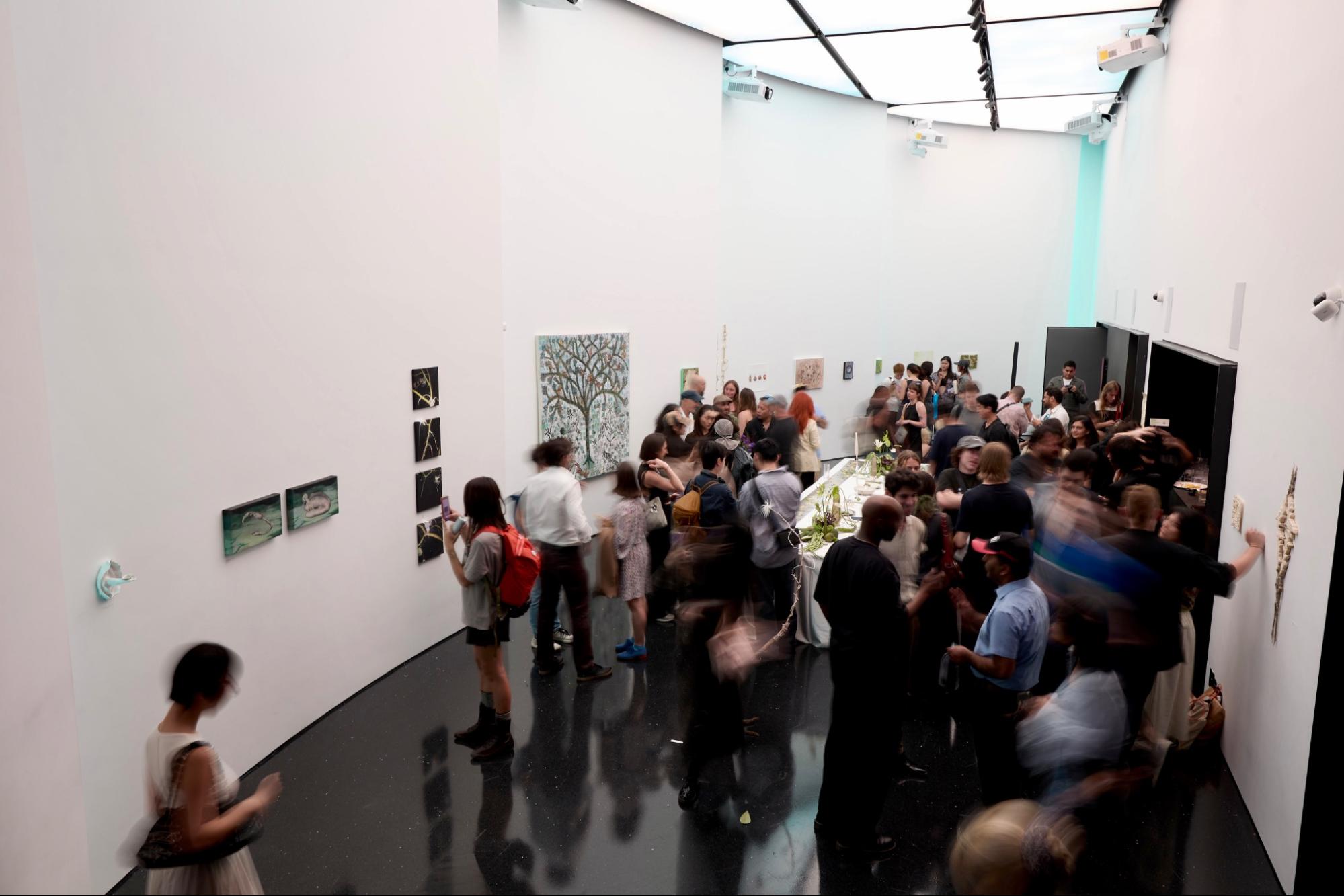

Exhibition Details:
Dates: June 27 – 29th, 2025
Opening: 6:00 PM, Jun 27th, 2025
Location: Art’otel London Hoxton Gallery and Auditorium, 1-3 Rivington St, London EC2A 3DT
Curators:
Moyu Yang, Chang Wang
Participating Artists:
Anyi Ji, Phong Anh Nguyễn, Cosima Von Moreau, Caitlin Hazell, Lancy Liu, Xueting Chen, Katya Morgansykes, Ume Dahlia, Ruixin Wang, Ruiyi Wang, Xin Zhang, James Lang, Kuangyi Lu, Aura Sun, Jingshan Ding, Tianxi Wang, Yichen He, Wanting Wang
Abbie Wilson produced this piece with the generous editorial contribution of Daniel Northover.
